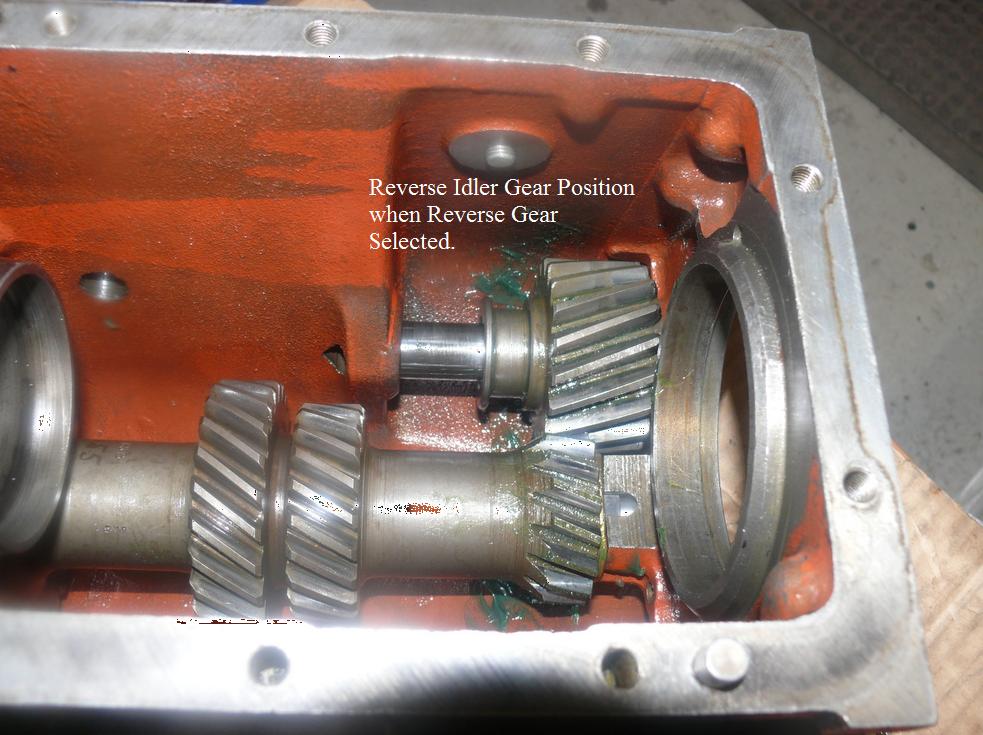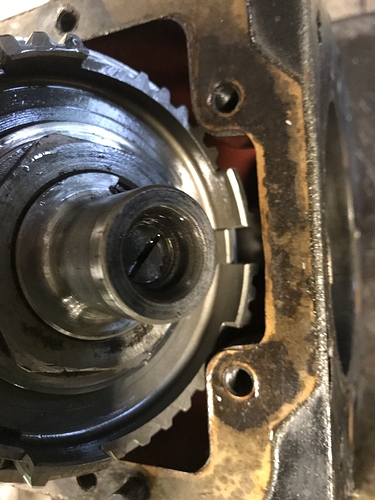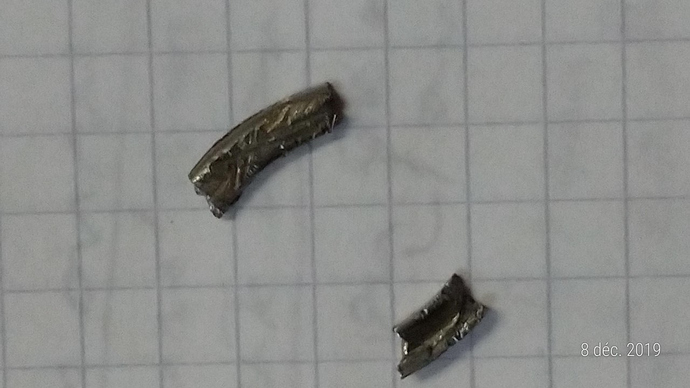Dear all, a new issue with my car.
Progressively appeared a noise similar a gear turning and knocking the ground.
This noise is rather strong and stops when disengaging the clutch.
It seems to come from the gearbox but I am not sure and it can be due to a failure of many parts in addition to the gearbox, all the universal joints, final drive unit …
What would you advise me to do to make the right diagnosis ?
Many thanks in advance.
Christophe
4.2 l 1966 FHC
To possibly narrow it down - does it happen in all gears? Does it happen in neutral (and car moving)? Does it seem to be engine speed-related or road-speed-related?
There are only two things you can try before pulling the engine, change your g-box fluid, and grease u-joints (assuming they aren’t sealed for life). I’d be doing that before anything else. Both can be done in 60-90 minutes.
Thank you Geo. To answer your questions, when it started I thought it was limited to 3rd gear but after it also occurred in the other gears. In neutral I do not know. Seems rather road-speed related.
Thank you very much also Erica. In fact I made a complete maintenance a few weeks ago. The gearbox fluid is brand new. I checked the level after failure and it is quite correct. I also greased all the u-joints. So nothing more to be done in this respect.
In your opinions, what should I look for, mechanical clearances/relative movements ?
Drive it down the road: de-clutch it at about 30 mph, and shut down the engine.
Noise stops, likely a trans issue: noise doesn’t stop, likely propshaft/halfshaft issue.
Paul’s suggestion is a good one. You might also want to pull the console and tunnel cover so you can really hear exactly where the sound is coming from. It certainly could be worn needle bearings on the g-box shafts. Easy enough to fix…except for the whole part about removing the engine 
But if it’s failing u-joints, then you can get to that in a couple hours by dropping the IRS. This is why you have to know exactly where it’s coming from.
Oh, and if you do this, put some tape across the tunnel over the u-joint in case grease gets flung out, and for heaven sake keep your hands out of there and the windows open in case you have an exhaust leak.
Does it matter if he leaves it in gear or neutral when he presses in the clutch and shuts down the engine?
Left declutched, in neutral, will isolate driveshafts: in neutral, foot off clutch will indicate if a trans issue may exist.
Dear all, I drained the oil from the gearbox and had some metal bits coming.
So I think it is likely the failure comes from the gearbox.
I removed it (with the engine) from the car and am now in the process of dismantling it.
I am using Haynes owners workshop manual.
After removing the rear end cover, they say “Remove the reverse gear pinion shaft by pulling it to tthe rear of the gearbox”.
I do not succeed in doing this. Does anybody have a tip or explanation on the way to proceed ?
Many thanks in advance and best regards.
Hello Chris,
As Paul points out in his Post, if the noise is there when in neutral with clutch engaged (foot off of clutch pedal) and disappears when the clutch is disengaged (car stationary, otherwise the Main Shaft is being driven by the back wheels), the issue is with the gearbox.
If you only have the back cover (actually the Oil Pump and Speedo Drive housing) removed, removing the Reverse Idler Gear shaft at that stage is the wrong thing to be doing. Further, even with the Main Shaft and Lay Shaft Cluster removed, removing the Reverse Idler Shaft by trying to pull it to the rear is a near impossibility, unless its very loose in the housing and you can get it started to move with a strong pot magnet. You can sometimes get the Reverse Idler Gear Shaft to start to back out via inertia, by making sharp blows to the rear face of the Gearbox Housing with a Nylon Faced hammer, but more times than not, this method doesn’t work if the shaft, or the Woodruff Key engaged with the Gearbox Housing is just a little tight.
I make these shafts and I provide a small diameter tapped hole in the back end of the shaft so that a slide hammer can be used to extract it.
To get the original shaft out, you have to attack it from the front end of the shaft (inside the gearbox) and to do this you need to access the end through the hole shown in the picture below.
This picture show the Lay Shaft Cluster and First Motion Shaft still in place. You need these to be out of the Gearbox Housing and you will be able to use a small diameter drift (aluminium or brass), at an angle to the long axis of the shaft, through the bore for the First Motion Shaft Bearing. Once you get the shaft moving and it’s end protruding from the back face of the Gearbox Housing, you should be able to extract it by pulling it by hand to the rear.
I had the First Motion Shaft and Lay Shaft Cluster in place only to confirm that the noise in this gearbox, the same that you’re experiencing, was being caused by the Reverse Idler Gear (see the two pictures below) and I suspect that its the Reverse Idler Gear that is causing the noise in your Gearbox
With only the components shown in the above pictures left assembled in the Gearbox Housing, I’m able to run the Lay Shaft Cluster and Reverse Idler Gear by driving the First Motion Shaft. I have a rig set up to do this, but you can use an electric hand drill coupled to the First Motion Shaft via a sturdy rubber hose. When the revers idler gear was moved to the Neutral or Forward Gear position, the area of the gear that engages with the reverse gear is in mesh with the Lay Shaft Cluster and the noise was apparent. When the Reverse Idler Gear was moved to the rear position, where it would be when in mesh with Reverse Gear, the noise disappeared.
Regards,
Bill
Hello Chris,
Further to my last Post, I borrowed a Haynes manual to see how they described the dismantling of the Gearbox. Most of the description is based around the earlier Moss box and the Reverse Idler Gear Shaft is quite different to that in your Gearbox; in many instances, it come out with the removal of the rear end cover. You would do better to obtain a manual that relates to the All Synchromesh Gearbox, such as for the S2 and S3 cars.
Getting back to the noise you have, it can be easily determined if the Reverse Idler Gear is the cause.
- Assemble the First Motion Shaft, Lay Shaft Cluster, and the Reverse Idler Gear in the Gear Case as shown in the pictures of my previous Post.
- Take a short length of flexible hose, the bore of which is a firm fit on the forward journal of the First Motion Shaft and clamp it to the First Motion Shaft using a suitable hose clamp.
- Take a short length of steel rod that is a firm fit in the Bore of the flexible hose, insert enough of its length in the bore of the hose to be able to use a hose clamp to secure it.
- catch the other end of the rod in the chuck of a portable electric drill.
You can now drive the Lay Shaft Cluster and Reverse Idler Gear by running the First Motion Shaft up to speed. - with the gears rotating at speed, alternatively move the Reverse Idler Gear between the forward and rearward positions as shown in the pictures in my previous Post.
If the reverse Idler Gear is the issue, it will by noisy when in the forward location and considerably quieter when moved to the rear, where it would be when engaged with Reverse Gear.
Ensure that you lubricate the gears that are in mesh during this test, as all gears make some noise when dry. Grease is the best lubrication for this test.
The metal that you found in the Gearbox is most likely from the rear area of the Lay Shaft. Very little metal comes from the supposed grating of gears. The gears never actually grate when a gear change messed up, as they are in constant mesh. The grating noise comes form the teeth of the Synchro Hub, the shape of which tend to resist chipping.
Its very common to see extreme wear at the rear end of the Lay Shaft. Some years subsequent to your gearbox, Jaguar changed the material used in the Lay Shaft. I manufacture both the Lay Shaft and the Reverse Idler Gear Shaft from EN36A case hardening steel that is double heat treated (Case Harden and Core Refined) before precision grinding to size.
If you find that the noise is, as I suspect, coming from the Reverse Idler Gear, there is no option other than to replace it.
Regards,
Bill
Christophe, you state that with 3rd gear engaged you first heard a knocking .
The cause is most likely the surface of the spigot at the front end of the mainshaft
breaking up along with it`s companion needle roller in the first motion shaft.
No need to extract the reverse idler shaft, just disconnect the reverse operating lever.
Peter B
Having done my 4.2 gearbox last year… Put a hose clamp on the end of the tailshaft lest the gears slide rearward allowing the needles to fall like Christmas tree needles on January 4th. You do not want a needle in the bottom of the case.
Also, while it’s apart, swap out the brass syncros but beware, I got a bad one, not machined properly at the outer teeth. It would not engage the ring. Test before buttoning up.
Also, there will be a thrust washer on a pin at the rear of the laygear, It’s a PITA, but if handled properly and swung out of the way you’ll be fine.
Thank you very much Bill, Peter and Mitchell for your very detailed and clear pieces of advice.
As far as I experienced, the noise always disappeared when I de-clutched the engine and, since I found some magnetic metal bits in the oil and gearbox, I think there is at least something to do there.
The two bits on the following picture came with the gearbox oil.
The paper’s squares side size is 5 mm or 1/5".
From all what you explained me, I shall leave the reverse gear pinion shaft in place and try to continue dismantling the gearbox without removing it.
I shall then make the tests you proposed to identify the failure.
By the way, Haynes describes a 11.25" long dummy countershaft while some posts suggest to make a shorter one, down to 8" or so.
What is your recommendation for the Jaguar All Synchromesh Gearbox ?
Many thanks again. I wish you all a Happy New Year.
Kind regards.
Christophe.
New year regards to you Christophe.
The pieces look to be the edges of the needle roller pressed in the first motion shaft (photo)
With 3rd gear selected, cross rotational loading at the mainshaft spigot / needle roller interface, (my thats a mouthfull to start the new year with posters) is high, so your mention
of the first indication of a problem when 3rd gear was selected points in this direction.
The mainshaft spigot will require some work, the needle roller can be replaced.
The length of the dummy shaft is 8 5/16" but 211 mm is OK.
Peter B
Thank you very much Peter !
Christophe, while it has been over 30 years since I rebuilt my gearbox, I do remember that the Bentley manual provided very clear step-by-step instructions for the all-synchro transmission. Never having used the Haynes version I don’t know how it compares, but investing in the Bentley might be worthwhile as another point of reference.
Hello Jack. Thank you very much for the suggestion. I’ll try to find it.
For information I have been using the Haynes for 23 years and it is generally very reliable.
Best regards.
Christophe
I agree with Peter, looks like the needle roller in the first motion shaft has collasped. Unfortunately a normal failure, even more so behind the V12 engine.
I normally replace with the higher rated full complement type.
You can repair main shaft by machining down and pressing on an inner race.
Dear all,
I built the dummy countershaft and removed the constant pinion shaft.
Then I found a mix of broken needles between the mainshaft and constant pinion shaft and unfortunately both axle surfaces were damaged.
At this point I have 2 questions :
- These axles seem unavailable so what is the best way to repair them and what are the diameters to be reached ?
- What is the way to remove the circlip retaining the mainshaft bearing and dismount the mainshaft ?
Kind regards.
Christophe.





